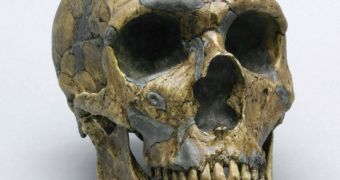The Neanderthals inhabited Europe and neighboring areas of western Asia. Early proto-Neanderthal feathers were found in Europe in fossils which were 350,000 years old. 130,000 years ago, fully Neanderthal traits appeared. The Neanderthals started to be displaced by modern humans (Homo sapiens) about 45,000 years ago and about 24,000 years ago, the last of the Neanderthals vanished from southern Spain.
The image of a Neanderthal is that of a restless hunter, a mammoth slayer that relied exclusively on meat for survival. Despite all this, a tooth proof coming from a Neanderthal skeleton encountered in Iraq shows that these ancient humans also consumed plants, as revealed by a new research presented at the annual Paleoanthropology Society meeting in Vancouver, Canada.
Most data about the diet of the Neanderthal has come from indirect clues, like piles of animal bones discovered next to Neanderthal remains.
"The new hard evidence is microfossils of plant material that investigators found in the dental plaque of 35,000-year-old Neanderthal teeth. The formation of dental [plaque] traps the plant microfossils from food particles within the matrix of the plaque deposits, so the microfossils are protected and are a unique record of the plant foods put into the mouth. So we can say with confidence that this individual Neanderthal ate plants," said lead author Amanda Henry, a graduate student in hominid paleobiology at the George Washington University.
"They lived in many different environments and survived numerous climatic changes, including some of the coldest and harshest glacial periods. It seems logical to me that they took advantage of any food sources they had available in their environments, which would vary from place to place and from time to time. But there had been little hard evidence of variety in their diet," added Henry.
The skeleton from Iraq was found in the '50s at the Shanidar cave, in the Zāgros Mountains in the northeastern part of the country. The Shanidar III skeleton belonged to a male in his 40s and was represented by 4 teeth and several bone fragments. The soil around the skeleton was rich in pollen grains, a fact that made the researchers believe those Neanderthals had been buried with flowers as grave goods.
"Three of the teeth (of Shanidar III) had excellent preserved plaque that contained microscopic fossils of plant material. We know that this individual ate a variety of plants, including grass seeds, more commonly called grains today. The finding suggests that characterizing Neanderthals as obligate meat-eaters may be wrong, but there is still a lot more work to be done on this issue," said Henry.
"But the technique does not indicate whether an individual Neanderthal ate plants once or a thousand times. It also doesn't show the relative proportions of a food type in the individual's diet. By using a variety of techniques in tandem, we are going to get a much more realistic picture of paleodiets," said Matt Sponheimer from the University of Colorado in Boulder, who in 2006 published a study on the diet of Australopithecus based on the carbon isotope analysis of their teeth.

 14 DAY TRIAL //
14 DAY TRIAL //